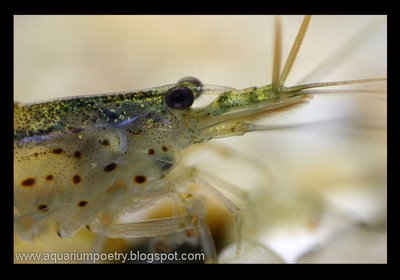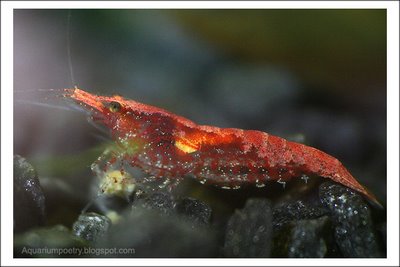Male Caridina multidentata (previous C. japonica)
 Female Caridina multidentata
Female Caridina multidentata (previous C. japonica)

The difference between males and females of C. multidentata are obvious.
Males are smaller. They reach size to 3.5cm, while females grow to about 5cm. You will see on the first photo that males body is far more transparent than females (second photo). Males have brown dots on their sides and females have rather short lines in combination with dots (line-dot-line-dot...). One can notice a huge difference in the size of their abdominal segments. Females abdominal segments (especially the first 4 out of 6) grow much deeper over the swimmerets/pleopods to accommodate the eggs.
Caridina multidentata has a short rostrum in comparison with other shrimp species (horn between the eyes).


Like any other crustaceans, C. multidentata changes the exoskeleton every now and then. Juveniles change it every 4 to 7 days while grown ups do it approx. every month or so. Reason for shedding the skin is to accommodate their growing bodies or simply to repare some damaged body parts. How often they will molt depends on temperature (22-27 Celsius is preferred range) and food type, but usualy all shrimps molt after the partial water change.
Breeding Caridina multidentata

The female starts developing eggs in their ovaries (photo above shows the "white saddle", forming eggs) before the actual fertilisation takes action. When the female feels ready for breeding, she starts releasing pheromones which will attract males. Males will sense it and go after the female. For the reason all males swim around the tank like crazy, some people think that the water quality is worsened, but this is not the case. They are just trying to get to the ready female. The chosen male is allowed to climb under the female and fertilise the eggs. A few days latter the female will drop the eggs (up to 400 eggs) onto the swimmerets/pleopods, where she will carry them for about 4-5 weeks.
 When the eggs form eyes (the photo below), it is known that the hatching is near (next 5-7 days). In my experience the first eggs hatched after about 10-15 days after I noticed the eyes.
When the eggs form eyes (the photo below), it is known that the hatching is near (next 5-7 days). In my experience the first eggs hatched after about 10-15 days after I noticed the eyes.
 When eggs hatch, the tiny 1-1.5mm larvae is released. The larvae should spend not more than 8 days in freshwater because it will need full marine salinity (35ppt). It will go through few larval stages before it transforms into post-larvae aka the miniature shrimp. The larvae will spend up to 30-60 days in marine water before fully transformed into a miniature shrimp. Then it can be placed in freshwater, where it will thrive for next 3-4 years (life span). It has been known that this shrimp is sexually mature when 6 month old. You can look into my Caridina multidentata breeding attempts Vol.1 and Vol.2 , as well as how important role, bog-wood and Oak leaf litter, plays in this shrimps diet (they eat the microorganisms, fungus and algae growing on the wood and leaves).
When eggs hatch, the tiny 1-1.5mm larvae is released. The larvae should spend not more than 8 days in freshwater because it will need full marine salinity (35ppt). It will go through few larval stages before it transforms into post-larvae aka the miniature shrimp. The larvae will spend up to 30-60 days in marine water before fully transformed into a miniature shrimp. Then it can be placed in freshwater, where it will thrive for next 3-4 years (life span). It has been known that this shrimp is sexually mature when 6 month old. You can look into my Caridina multidentata breeding attempts Vol.1 and Vol.2 , as well as how important role, bog-wood and Oak leaf litter, plays in this shrimps diet (they eat the microorganisms, fungus and algae growing on the wood and leaves).

Photos and text by Dusko Bojic.
 Male Red Cherry shrimp grows smaller (2.5cm) than the female (3.5cm). Males are pale and transparent with very little red/brown, while females are deep red (light red when juvenile).
Male Red Cherry shrimp grows smaller (2.5cm) than the female (3.5cm). Males are pale and transparent with very little red/brown, while females are deep red (light red when juvenile). For some reason young females release their first eggs after 1-2 days (photo above), but the next batches are carried till the eggs hatch. Click on the next link to see the shrimplets video;
For some reason young females release their first eggs after 1-2 days (photo above), but the next batches are carried till the eggs hatch. Click on the next link to see the shrimplets video;







